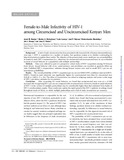| dc.contributor.author | Baeten, JM | |
| dc.contributor.author | Richardson, BA | |
| dc.contributor.author | Lavreys, L | |
| dc.contributor.author | Rakwar, JP | |
| dc.contributor.author | Mandaliya, K | |
| dc.contributor.author | Bwayo, JJ | |
| dc.contributor.author | Kreiss, J | |
| dc.date.accessioned | 2013-06-29T09:40:07Z | |
| dc.date.available | 2013-06-29T09:40:07Z | |
| dc.date.issued | 2005 | |
| dc.identifier.citation | Baeten JM, Richardson BA, Lavreys L, Rakwar JP, Mandaliya K, Bwayo JJ, Kreiss JK.;Female-to-male infectivity of HIV-1 among circumcised and uncircumcised Kenyan men;J Infect Dis. 2005 Feb 15;191(4):546-53. | en |
| dc.identifier.uri | http://www.ncbi.nlm.nih.gov/pubmed/15655778 | |
| dc.identifier.uri | http://erepository.uonbi.ac.ke:8080/xmlui/handle/123456789/42282 | |
| dc.description.abstract | BACKGROUND:
A lack of male circumcision has been associated with increased risk of human immunodeficiency virus type 1 (HIV-1) acquisition in a number of studies, but questions remain as to whether confounding by behavioral practices explains these results. The objective of the present study was to model per-sex act probabilities of female-to-male HIV-1 transmission (i.e., infectivity) for circumcised and uncircumcised men, by use of detailed accounts of sexual behavior in a population with multiple partnerships.
METHODS:
Data were collected as part of a prospective cohort study of HIV-1 acquisition among 745 Kenyan truck drivers. Sexual behavior with wives, casual partners, and prostitutes was recorded at quarterly follow-up visits. Published HIV-1 seroprevalence estimates among Kenyan women were used to model HIV-1 per-sex act transmission probabilities.
RESULTS:
The overall probability of HIV-1 acquisition per sex act was 0.0063 (95% confidence interval, 0.0035-0.0091). Female-to-male infectivity was significantly higher for uncircumcised men than for circumcised men (0.0128 vs. 0.0051; P=.04). The effect of circumcision was robust in subgroup analyses and across a wide range of HIV-1 prevalence estimates for sex partners.
CONCLUSIONS:
After accounting for sexual behavior, we found that uncircumcised men were at a >2-fold increased risk of acquiring HIV-1 per sex act, compared with circumcised men. Moreover, female-to-male infectivity of HIV-1 in the context of multiple partnerships may be considerably higher than that estimated from studies of HIV-1-serodiscordant couples. These results may explain the rapid spread of the HIV-1 epidemic in settings, found throughout much of Africa, in which multiple partnerships and a lack of male circumcision are common. | en |
| dc.language.iso | en | en |
| dc.publisher | University of Nairobi, | en |
| dc.title | Female-to-male infectivity of HIV-1 among circumcised and uncircumcised Kenyan men | en |
| dc.type | Article | en |
| local.publisher | College of Health Sciences, | en |


